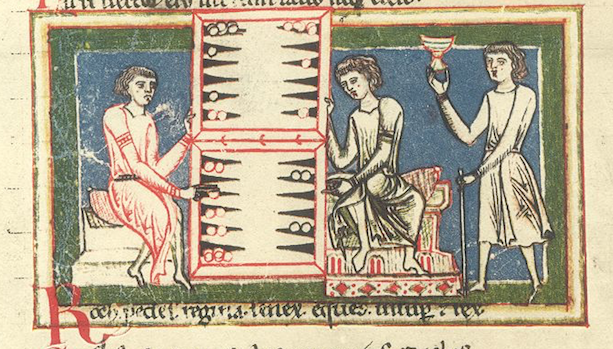The Songs from Benediktbeuern are undoubtedly some of the best-known early-Gothic manuscripts as well as one of the most spectacular rediscoveries of the 19th century. However, despite the research and their fame, the manuscript still keeps secrets from us.
The panoramic view of medieval Europe
It is not known how the Codex Buranus arrived in Benediktbeuern, where it was found in 1803. By the dialect of the Middle High German stanzas and the typical Italian gothic minuscule, one can assume that the manuscript originated in the Bavarian language area. However, the work transcends the geographical borders and shows us an incredible panorama of medieval Europe and life in the 13th century, with all its beauty and ugliness. A naturalistic image, free of any idealization that the French trouvéres poetry is known for.
Already after their rediscovery in the 19th century, the “Carmina Burana”, first mentioned in 1847 by Johann Andreas Schmeller, awoke interest among historians and musicologists. It owes its present-day fame above all to the scenic cantata by Carl Orff with the same title. 254 song and drama texts were thematically divided into six groups: Carmina ecclesiastica (religious songs) Carmina moralia et satirica (moral and satirical songs), Carmina amatoria (love songs), Carmina potoria (drinking songs), Ludi (spiritual games) and Supplementum (songs with various texts).1
It is indefinite who was responsible for the compilation of the poems, but there is no doubt about the authorship of the great medieval poets whose works were well known among the educated clerics of the time. Among them are Otto von Botenlauben, Philipp the Chancellor, Archipoeta, Walter von der Vogelweide, Hilary of Orleans. Over time, many myths spread over the original version. According to current knowledge, the term “Goliardic poetry” can only be used in a limited form. There is no convincing information, neither about the social status of the authors nor about their loyalty to the Church, since the goliardic poetry can be read as a literary construct. Therefore, we can speak of a medieval form of the so-called Erlebnislyrik, which experiments with different languages, stylistics, and topos.2

Paths to the music performance
Although the Codex Buranus is one of the best known anthologies of medieval songs, there is still no sufficient interpretation of the music notation. The already mentioned composer Carl Off has composed music for the texts, which does not correspond to the original and should not give the listener any connection to the original version. So how do the songs from Benediktbeuern sound? Neumatic notation gives us only imprecise information. Unlike many religious music books of the time, which have line systems, the neumes were written here over the lyrics, so it is not possible to pinpoint the melody. But nevertheless the musicologists find a possible musical interpretation. The word, as in most songs of those times, is strictly related to the musical expression. After the exact analysis you can see the repetitive schemes between the Latin and German stanzas and the noted neumes (mostly only with Latin stanzas). Also common elements of the medieval German repertoire were collected and can lead to some reconstructions.
What about the songs that the musical notation is not provided for? In any case, the unprovided notation should not suggest us lesser importance of those songs, but rather a fact they were commonly known, and therefore there was no need to write it down. Some of the songs reveal the similarities with the musical repertoire of Notre Dame, as well as some can be found in other manuscripts of the time; e.g. Exiit dilucolo rustica puella (CB 90) with only the first 8 verses written. Luckily we can find all 12 verses in the famous Codex de las Huelgas (early 14th century). In this case, the melody is identical but the lyrics are different. So what was the original version? The profane lyrics from the Carmina Burana or the religious version found in the Spanish Codex? The musicologist Walther Lipphardt claims the secular text fits much better to the last lines of the song from the Codex de las Huelgas. According to this thesis, it can be assumed that the secular version of the Codex Buranus was the first one. Despite all this information, we can only guess how the songs actually sounded. In any case, it is interesting evidence for further musicological research.3

Not merely the wheel of fortune
The medieval song manuscripts were rarely illuminated. In the case of Carmina Burana, the colored initials, numerous drawings, and miniatures suggest a well-equipped scriptorium. The most famous miniature of the Codex represents a wheel of fortune and the Roman fate goddess, Fortuna, wearing a crown and an ermine coat. Beside the wheel are shown the rise and fall of the sovereign, what symbolizes humans haughtiness and warns about the unpredictability of fate. “O Fortune, variable as the moon, always dost thou wax and wane.” 4 – this is how the famous “O Fortuna” begins.
Many love songs from the Codex are at the same time songs of praise to nature in spring and its vitalistic spirit. Floral motifs were very common in Early Gothic poetry manuscripts, and the only full-page miniature of the Codex is dedicated to them. A peculiarity, which can be spotted in the part of drinking songs, are three miniatures representing the board games. Such chess-play illustrations with a description of the arrangement rules came up so far only in Arabic literature and hereby occur for the first time in the Western culture.5
According to Peter and Dorothee Diemer, “the thematic selection and allocation of illuminations within the Codex does not seem to follow any systematic program” 6. They rather seem to play an ornamental role in the selected song groups. However, they were useful while determining the date of the Codex since some texts had been being added until the end of the 14th century, it could be specified – by the assessment of the miniatures to the first half of the 13th century – that the entire work was created around 1230-1240.7
The Codex Buranus is a complex, highly interesting work and one of the most important collections of songs of all time. Through the synthesis of poetry, music, the performing arts, and book illumination, the Codex follows the medieval tendency towards the performativity of art. It also proves a rich, secular music life in clerical centers of German-speaking countries. But above all, through its authentic, non-idealistic poetry, it reflects the spirit and charm of 13th century Europe.
Bibliographie:
1. Clasica 2, Revista de Ópera y Música Clásica; Los Goliardos y los Carmina Burana [Entrance: 28.01.2019]: https://bit.ly/2sVcIFi
2. H. Deeming, E.E. Leach, Manuscripts and Medieval Song, Cambridge University Press 2015, Kap. 4: G. Bobeth, Wine, women, and Song? Reconsidering the Carmina Burana, p.79
3. P. Dronke, The Medieval Poet and His World, Edizioni di Storia e Letteratura, Roma 1984, Poetic Meaning in the Carmina Buran, p.249-280
4. The full text of the „O Fortuna“ [Entrance: 28.01.2019]: https://lybio.net/medieval-latin-goliardic-o-fortuna-english-translation/poem/
5. cf. U. Schädler und R. Calvo, Alfons der Weise, Das Buch der Spiele,Ludographie I, 2009, p.44
6. Diemer, Peter und Dorothee, Die Illustrationen der Handschrift in: Carmina Burana. Texte und Übersetzungen. Mit den Miniaturen aus der Handschrift und einem Aufsatz von Peter und Dorothee Diemer, hg. von Benedikt K. Vollmann, Frankfurt 1987, p.1294
7. Peter Dronke, a critical Note on Schumann´s Dating of the Codex Buranus, “Beiträge zur Geschichte der deutschen Sprache und Literatur, LXXXIV (Tübingen,1962), p.181






